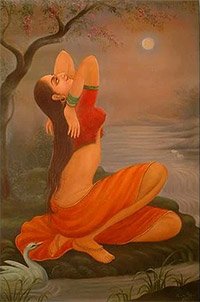Nimittajnana, Nimitta-jnana, Nimittajñāna: 3 definitions
Introduction:
Nimittajnana means something in Hinduism, Sanskrit. If you want to know the exact meaning, history, etymology or English translation of this term then check out the descriptions on this page. Add your comment or reference to a book if you want to contribute to this summary article.
In Hinduism
Kama-shastra (the science of Love-making)
Source: Shodhganga: Elements of Art and Architecture in the Trtiyakhanda of the Visnudharmottarapurana (kama)Nimittajñāna (निमित्तज्ञान) refers to “art of addressing spells, charms, auspicious and bad signs etc.” and represents one of the “sixty four kinds of Art”, according to the Kāmasūtra of Vātsyāyaṇa.—Indian tradition, basically includes sixty four Art forms are acknowledged. The references of sixty four kinds of kalā are found in the Bhāgavatapurāṇa, Śaiva-Tantras, Kāmasūtra of Vātsyāyaṇa etc.

Kamashastra (कामशास्त्र, kāmaśāstra) deals with ancient Indian science of love-making, passion, emotions and other related topics dealing with the pleasures of the senses.
Pancaratra (worship of Nārāyaṇa)
Source: archive.org: Catalogue of Pancaratra Agama TextsNimittajñāna (निमित्तज्ञान) refers to “significance of omens”, as discussed in the ninth chapter of the Paramasaṃhitā: one of the older texts of the Pāñcarātra canon consisting of over 2100 verses in 31 chapters which, being encyclopedic in scope, deals with philosophy, worship routines, mantras, initiation, social behavior, temple-building, etc.—Description of the chapter [nimittajñāna]: In dīkṣā, or at the commencement of any important undertaking, it is important to be alert to certain omens (nimitta) (1). For example, after brushing his teeth the initiate tosses his toothbrush-stick and, depending on the way it falls and the direction it points, much can be foretold (2-10). Also, dreams of the initiate foretell significantly what the future holds (11-33). As well, keeping an eye on the shape, size and color of the flames of the homa-fire can instruct one concerning good and evil portents (34-38a). Even natural happenings are symptomatic of future events (38-39). In all, one should be prepared to read all signs with care for what they can tell of the outcome of an important undertaking (40-44).

Pancaratra (पाञ्चरात्र, pāñcarātra) represents a tradition of Hinduism where Narayana is revered and worshipped. Closeley related to Vaishnavism, the Pancaratra literature includes various Agamas and tantras incorporating many Vaishnava philosophies.
Languages of India and abroad
Sanskrit dictionary
Source: Cologne Digital Sanskrit Dictionaries: Monier-Williams Sanskrit-English Dictionary1) Nimittajñāna (निमित्तज्ञान):—[=nimitta-jñāna] [from nimitta] n. ‘knowledge of omens or signs’, Name of [chapter] of the Kāma-sūtra by Vātsyāyana
2) [v.s. ...] cf. [Religious Thought and Life in India 397.]
Sanskrit, also spelled संस्कृतम् (saṃskṛtam), is an ancient language of India commonly seen as the grandmother of the Indo-European language family (even English!). Closely allied with Prakrit and Pali, Sanskrit is more exhaustive in both grammar and terms and has the most extensive collection of literature in the world, greatly surpassing its sister-languages Greek and Latin.
See also (Relevant definitions)
Partial matches: Jnana, Nimitta.
Query error!
Full-text: Pushpashakatika, Ashtangamahanimittajnana, Nimitta, Pushpasakatikanimittajnana, Pushpashakati, Addressing, Sign, Auspicious sign, Charm, Spell.
Relevant text
Search found 6 books and stories containing Nimittajnana, Nimitta-jnana, Nimitta-jñāna, Nimittajñāna; (plurals include: Nimittajnanas, jnanas, jñānas, Nimittajñānas). You can also click to the full overview containing English textual excerpts. Below are direct links for the most relevant articles:
Vishnudharmottara Purana (Art and Architecture) (by Bhagyashree Sarma)
3. A General Note on Art < [Chapter 1 - Introduction]
Parama Samhita (English translation) (by Krishnaswami Aiyangar)
Kamashastra Discourse (Life in Ancient India) (by Nidheesh Kannan B.)
7.1. The Sixty-four Fine Arts < [Chapter 5 - Looking for Alternatives: Possibilities in Kāmaśāstra]
Malatimadhava (study) (by Jintu Moni Dutta)
Part 3 - Art and Architecture in the Mālatīmādhava and 8th-century India < [Chapter 4 - Cultural Aspects of the Mālatīmādhava]
Kamashastra and Classical Sanskrit literature (study) (by Vishwanath K. Hampiholi)
Chapter 1.3 - The supplementary Arts and Sciences < [Chapter 2 - Kamasutra part 1 (Sadharana-adhikarana)—Critical study]
Hindu Architecture in India and Abroad (by Prasanna Kumar Acharya)